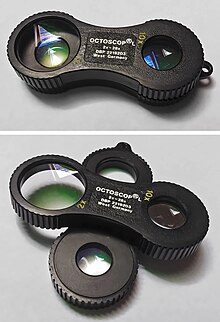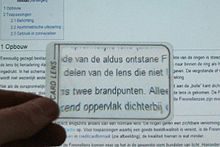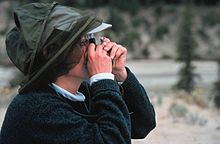Magnifying glass
A magnifying glass (from French loupe), also called magnifying glass or burning glass , is a simple convex converging lens with a small focal length with a mount and handle or a device for setting up. If an object is within the focal length , a magnifying glass creates an upright virtual image of the object.
history
The enlargement effect by means of water is since the 1st century by Seneca d. J. occupied. The invention of the magnifying glass as an optical device is attributed to the Arab scholar Abu Ali al-Hasan Ibn Al-Haitham (Latinized Alhazen ) (11th century, text “ Treasure of Optics ”). The minstrel Konrad von Würzburg addressed the following verses to the Virgin Mary in the 13th century: “I have compared you to a crystalline stone ... It has in it the great and mighty way that a script would never be so small, its appearance in he would get bigger: If this stone covered it and overran it, if someone cut it thinly and wanted to hold it on the writing, he would see the small letters appear larger through it. "
functionality
Objects that are beyond the viewer between the magnifying glass and the focal plane (i.e. within the focal length ) appear larger through a magnifying glass . This effect of a magnifying glass results on the one hand from the fact that one can accommodate with it on an object from a shorter distance than would be possible with the clear-sighted eye . On the other hand, the magnifying glass provides an enlarged virtual image. The second effect is also used to determine the magnification ( see below ).
Used as a visual aid , it compensates for hyperopia (farsightedness) or presbyopia (presbyopia), as the eye can accommodate infinitely with a magnifying glass (this is often perceived as relaxing by those affected). The use of a magnifying glass, in which the viewer sees an enlarged virtual image, should not be confused with the correction of hyperopia or presbyopia. During the correction, the lens used is also a convex lens, but here with a significantly larger focal length or with a lower refractive power (“diopter value”) and is worn directly in front of the eye as glasses or contact lenses. The lens of the glasses or the contact lens forms a lens system or a functional unit with the optical apparatus of the eye.
In contrast to glasses, the magnifying glass does not have to be adjusted for hyperopia or presbyopia. Therefore, every reading magnifier can always be used as a makeshift solution for missing glasses or contact lenses. Myopia (nearsightedness) cannot be corrected with a magnifying glass.
Construction of the virtual image
When constructing the virtual image (see fig.), Two rays are used which emanate from a point on the object (here: from the arrowhead of the object): The “main ray” - that is, the ray that passes through the center of the lens goes - experiences approximately no refraction. The “parallel beam” (blue in the picture) becomes a “focal beam” when the lens is refracted, ie it passes through the focal point. The viewer, who is to the right of the lens in the illustration, assumes that the light propagates in a straight line. For him, the light seems to emanate from the point where the red lines that have been traced back intersect. So the arrowhead of the virtual image is right there.
The object must be within the focal length ( ) to see it enlarged through the magnifying glass. The magnifying glass is ideally held when it is in focus ( ). The rays then run parallel. The object appears to be infinitely far away and the eye can comfortably accommodate at a great distance . The magnification results from the ratio of the viewing angle with and without visual aid. The clear visual range is often chosen as the reference value .
Types of magnifiers and related devices
In addition to special magnifying glasses, such as reading sticks (magnifying glass with direct support on the reading material and magnification in one dimension), reading stones (also with direct support but two-dimensional enlargement), measuring magnifiers such as B. thread counters , watchmaker magnifiers , magnifying glasses , magnifiers with complex lens systems ( aplanats , achromatic lenses , etc.), check cards magnifiers ( Fresnel lens ) u. v. a. there are two basic types that differ mainly in their application:
Reading magnifier
Reading magnifiers usually magnify 2 to 6 times. Another characteristic is their relatively large field of view due to a large lens diameter. This large field of view makes it possible to take a generous and variable distance between the reading lens and the head (eyes) with a constant distance between the reading magnifier and the reading material (object). Reading is therefore possible in a comfortable position. Three-dimensional vision is possible if there is enough distance between the reading magnifier and the eyes and if the magnification is low.
While the classic reading magnifier is a large lens with a metal frame and a handle (think of the typical appearance of Sherlock Holmes with a magnifying glass - piquantly, he always uses a reading magnifier instead of a detailed magnifier), modern reading magnifiers are often illuminated (illuminated magnifiers), spacers or other devices.
Reading stones and reading sticks (the latter only enlarge in one dimension as a cylinder lens ) are flat on the underside and are placed directly on the reading material. This defines the distance between the reading material and the curved upper side, which is effective for the magnifying glass, and the hand cannot shake. These reading stones are heavy according to their volume.
Detail magnifier

The detail magnifier has a typical magnification of 5 to 15 times - with very good quality, a little more. The lens has a small diameter (about 1–3 cm) which means that the field of view is very small.
This small design requires a completely different way of working with the detail magnifier than with the reading magnifier. While the distance between the object and the magnifying glass is also fixed here, one tries to obtain a larger field of view by keeping a very small distance between the magnifying glass and the eye. A typical case is the watchmaker's loupe , which is clamped in front of the eye. But other detailed magnifying glasses (e.g. magnifying glasses for nature observation of rocks and minerals in the field, or flowers and insects in the field) are brought directly to the eye to enable a larger field of vision. The correct use of such magnifiers usually requires a little practice, as one is usually not used to placing objects directly in front of the eye.
Three-dimensional vision is not possible here. At this point, however, reference is made to magnifying glasses or special and correspondingly expensive binocular magnifying glasses.
Measurement / calculation of the focal length
The focal length of a magnifying glass determines its magnification and is therefore its most important parameter. In order to calculate the magnification (see below), the focal length must therefore be known.
In sunlight, the focal length can be determined with sufficient accuracy for everyday use by using the magnifying glass to minimize the circular light spot that it creates when imaging on a sheet of paper and by measuring the distance between the magnifying glass and paper. This distance corresponds to the focal length. If no sunlight is available, the focal length can also be measured using the (real, upside-down) image of distant objects, for example using the image of a window inside the room (see right).
Another pure measuring method is the determination of the focal length using autocollimation .
The focal length can be calculated precisely (assuming a correspondingly good measurement) using several methods:
- with the Newtonian mapping equation (this can be derived from the lens equation)
- with the Bessel method
- with the Abbe method
Determination of the magnification
The (quantitative) magnification of a magnifying glass is given as a reference value relative to viewing from the clear visual range (also called standard visual range ) .

An object appears at this distance at the angle (named in the adjacent figure ; in addition, the clear visual range in the figure corresponds to the distance ):
- with : object size (object size) in mm
The eye is relaxed when it accommodates at a great distance. This is the case for a large image range . It increases as the object distance approaches the focal length of the magnifying glass.
In the borderline case , the enlarged image appears at the angle (named in the figure ):
For the enlargement follows:
This calculation assumes that the eye is relaxed, i.e. H. is infinitely accommodated. There is then no virtual image. However, if you strain the eye, you can practically bring the object closer to the magnifying glass, so that a virtual image is created at a distance of the minimum visual range of the eye in question. The magnifying glass must be close to the eye, the refractive powers of the magnifying glass and the near-accommodated eye add up and the magnification is:
- example
A magnifying glass with a focal length of 50 mm makes it possible to view an object from a distance of 50 mm instead of from the distance of the clear visual range of 250 mm. According to the definition, the magnifying glass magnifies 5 times ( v = 250 mm / 50 mm ). The near-accommodated eye of a young or short-sighted person allows practical magnifications of up to 7.5 times and up to 5.5 times.
Using the magnifying glass as a magnifying glass
The name burning glass comes from the fact that the convex lens bundles the incident sun rays and thus increases the energy density of the light so much that flammable material such as paper or the like can be ignited. This property of the lens is also the origin for the optical terms focal point , focal plane , focal length etc.
The lens diameter has the greatest influence: the larger, the more light (power) is bundled. In addition, a shorter focal length of the lens (i.e. a higher magnification of the magnifying glass) results in an image of the solar disk on a smaller focal point. Due to the thus increased luminance , the attainable temperature rises during the absorption of the light in the irradiated medium. An ideal point (as a focal point) can never be reached with a real lens , also because of lens defects .
Whether and how quickly a material can be fired depends not only on the energy density provided by the burning glass, but also on the ignition temperature of the material and the thermal conditions (material thickness, thermal conductivity ) at the focal point.
The burning glass effect is used in the heliograph to record the sunshine of a day.
Warning notice
Magnifying glasses are flammable when exposed to direct sunlight, as they can ignite materials that are accidentally hit by the moving image of the sun. Magnifiers that are not in use must be provided with a protective cover / cap or kept in a light-proof container. There are many known cases in which the decoration of magnifying glasses (including photo lenses) in a shop window caused a fire.
Web links
Individual evidence
- ↑ Duden keyword “Lupe”. Retrieved June 10, 2015 .
- ^ Wolfgang Münchow: History of ophthalmology. 2nd edition Leipzig 1983, p. 170 f.
- ↑ EMO optics Arthur Seibert Octoscop L . photo.net. Retrieved May 26, 2020.
- ↑ This definition is necessary because, unlike binoculars or telescopes, magnifying glasses and microscopes do not have a magnification because they map lengths to angles. How many times does a magnifying glass magnify that allows you to look at 8 mm at an angle of 11 °?
- ↑ Magnifying glass on windowsill ignites apartment in Königsbronn. December 26, 2012, accessed June 10, 2015 .
- ↑ Lupe started fire. February 19, 2008, accessed June 10, 2015 .
- ^ Fire in Betzenhausen: The burning glass effect was to blame. (No longer available online.) May 28, 2010, archived from the original on June 10, 2015 ; accessed on June 10, 2015 . Info: The archive link was inserted automatically and has not yet been checked. Please check the original and archive link according to the instructions and then remove this notice.



























